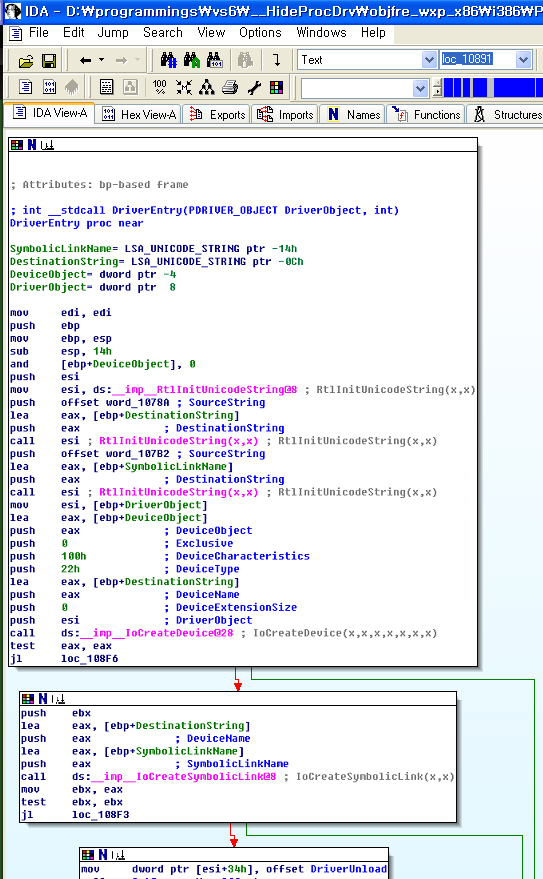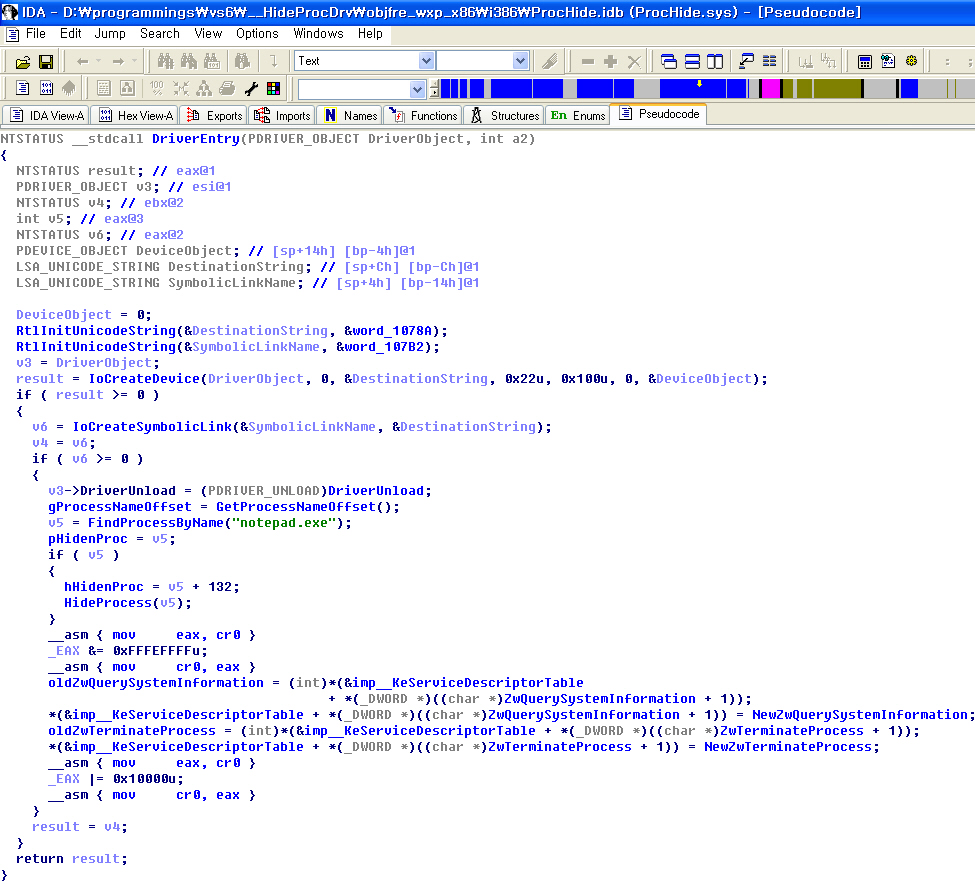반응형
IDA Pro는 OllyDbg보다 시각적인 부분과 Symbol 찾는 것 등에 장점이 있다.
하지만, 기능이 많고, 메뉴가 숨어있는 탓에 사용법이 어렵고, 익숙해지기 힘든 점이 있다.
나에게도 여전히 OllyDbg가 익숙하며, IDA는 코드의 흐름을 보거나 Symbol에 대한 정리가 필요할 때 잠깐씩 이용한다.
하지만, 잡스럽게 여러 도구들을 이용하는 것보다, 하나의 도구에 익숙해지려 했다.
그래서 간략히 IDA에 대해 정보를 찾던 중 Hex-Ray라는 좋은 플러그인이 있다길래 공부하는 겸 해서 정리한다.
Hex-Ray는 http://www.hex-rays.com/ 의 프로젝트 페이지를 갖고 있으며,
주요 메뉴얼에 대한 정보는 http://www.hex-rays.com/manual/ 에 나와있다.
Hex-Ray에 대해 짧게 기술을 한다면, De-Compiler이다.
OllyDbg나 IDA Pro는 기본적으로 Dis-Assembler의 속성을 갖고 있다.
그래서, Assembly 코드를 잘 표현하는데에 기능이 치중되어있다.
하지만, 그 정보를 활용해 De-Compiler의 기능을 플러그인으로 구현한 것이 Hex-Ray이다.
Hex-Ray를 이용하면, 우리에게 보다 친숙한 C 코드로 변환된 바이너리를 볼 수 있다.
(아래 : 기본적인 Dis-Assemble된 코드)
위 그림은 프로세스를 숨기기 위해 작성된 DKOM 드라이버 코드를 나타내고 있다.
아래 그림은 위 코드를 F5 단축키를 통해 Psuedo C Code로 변환된 드라이버의 모습을 나타내고 있다.
이를 텍스트로 옮기면 아래와 같다.
하지만, 기능이 많고, 메뉴가 숨어있는 탓에 사용법이 어렵고, 익숙해지기 힘든 점이 있다.
나에게도 여전히 OllyDbg가 익숙하며, IDA는 코드의 흐름을 보거나 Symbol에 대한 정리가 필요할 때 잠깐씩 이용한다.
하지만, 잡스럽게 여러 도구들을 이용하는 것보다, 하나의 도구에 익숙해지려 했다.
그래서 간략히 IDA에 대해 정보를 찾던 중 Hex-Ray라는 좋은 플러그인이 있다길래 공부하는 겸 해서 정리한다.
Hex-Ray는 http://www.hex-rays.com/ 의 프로젝트 페이지를 갖고 있으며,
주요 메뉴얼에 대한 정보는 http://www.hex-rays.com/manual/ 에 나와있다.
Hex-Ray에 대해 짧게 기술을 한다면, De-Compiler이다.
OllyDbg나 IDA Pro는 기본적으로 Dis-Assembler의 속성을 갖고 있다.
그래서, Assembly 코드를 잘 표현하는데에 기능이 치중되어있다.
하지만, 그 정보를 활용해 De-Compiler의 기능을 플러그인으로 구현한 것이 Hex-Ray이다.
Hex-Ray를 이용하면, 우리에게 보다 친숙한 C 코드로 변환된 바이너리를 볼 수 있다.
(아래 : 기본적인 Dis-Assemble된 코드)
위 그림은 프로세스를 숨기기 위해 작성된 DKOM 드라이버 코드를 나타내고 있다.
아래 그림은 위 코드를 F5 단축키를 통해 Psuedo C Code로 변환된 드라이버의 모습을 나타내고 있다.
이를 텍스트로 옮기면 아래와 같다.
NTSTATUS __stdcall DriverEntry(PDRIVER_OBJECT DriverObject, int a2)
{
NTSTATUS result; // eax@1
PDRIVER_OBJECT v3; // esi@1
NTSTATUS v4; // ebx@2
int v5; // eax@3
NTSTATUS v6; // eax@2
PDEVICE_OBJECT DeviceObject; // [sp+14h] [bp-4h]@1
LSA_UNICODE_STRING DestinationString; // [sp+Ch] [bp-Ch]@1
LSA_UNICODE_STRING SymbolicLinkName; // [sp+4h] [bp-14h]@1
{
NTSTATUS result; // eax@1
PDRIVER_OBJECT v3; // esi@1
NTSTATUS v4; // ebx@2
int v5; // eax@3
NTSTATUS v6; // eax@2
PDEVICE_OBJECT DeviceObject; // [sp+14h] [bp-4h]@1
LSA_UNICODE_STRING DestinationString; // [sp+Ch] [bp-Ch]@1
LSA_UNICODE_STRING SymbolicLinkName; // [sp+4h] [bp-14h]@1
DeviceObject = 0;
RtlInitUnicodeString(&DestinationString, &word_1078A);
RtlInitUnicodeString(&SymbolicLinkName, &word_107B2);
v3 = DriverObject;
result = IoCreateDevice(DriverObject, 0, &DestinationString, 0x22u, 0x100u, 0, &DeviceObject);
if ( result >= 0 )
{
v6 = IoCreateSymbolicLink(&SymbolicLinkName, &DestinationString);
v4 = v6;
if ( v6 >= 0 )
{
v3->DriverUnload = (PDRIVER_UNLOAD)DriverUnload;
gProcessNameOffset = GetProcessNameOffset();
v5 = FindProcessByName("notepad.exe");
pHidenProc = v5;
if ( v5 )
{
hHidenProc = v5 + 132;
HideProcess(v5);
}
__asm { mov eax, cr0 }
_EAX &= 0xFFFEFFFFu;
__asm { mov cr0, eax }
oldZwQuerySystemInformation = (int)*(&imp__KeServiceDescriptorTable
+ *(_DWORD *)((char *)ZwQuerySystemInformation + 1));
*(&imp__KeServiceDescriptorTable + *(_DWORD *)((char *)ZwQuerySystemInformation + 1)) = NewZwQuerySystemInformation;
oldZwTerminateProcess = (int)*(&imp__KeServiceDescriptorTable + *(_DWORD *)((char *)ZwTerminateProcess + 1));
*(&imp__KeServiceDescriptorTable + *(_DWORD *)((char *)ZwTerminateProcess + 1)) = NewZwTerminateProcess;
__asm { mov eax, cr0 }
_EAX |= 0x10000u;
__asm { mov cr0, eax }
}
result = v4;
}
return result;
}
RtlInitUnicodeString(&DestinationString, &word_1078A);
RtlInitUnicodeString(&SymbolicLinkName, &word_107B2);
v3 = DriverObject;
result = IoCreateDevice(DriverObject, 0, &DestinationString, 0x22u, 0x100u, 0, &DeviceObject);
if ( result >= 0 )
{
v6 = IoCreateSymbolicLink(&SymbolicLinkName, &DestinationString);
v4 = v6;
if ( v6 >= 0 )
{
v3->DriverUnload = (PDRIVER_UNLOAD)DriverUnload;
gProcessNameOffset = GetProcessNameOffset();
v5 = FindProcessByName("notepad.exe");
pHidenProc = v5;
if ( v5 )
{
hHidenProc = v5 + 132;
HideProcess(v5);
}
__asm { mov eax, cr0 }
_EAX &= 0xFFFEFFFFu;
__asm { mov cr0, eax }
oldZwQuerySystemInformation = (int)*(&imp__KeServiceDescriptorTable
+ *(_DWORD *)((char *)ZwQuerySystemInformation + 1));
*(&imp__KeServiceDescriptorTable + *(_DWORD *)((char *)ZwQuerySystemInformation + 1)) = NewZwQuerySystemInformation;
oldZwTerminateProcess = (int)*(&imp__KeServiceDescriptorTable + *(_DWORD *)((char *)ZwTerminateProcess + 1));
*(&imp__KeServiceDescriptorTable + *(_DWORD *)((char *)ZwTerminateProcess + 1)) = NewZwTerminateProcess;
__asm { mov eax, cr0 }
_EAX |= 0x10000u;
__asm { mov cr0, eax }
}
result = v4;
}
return result;
}
아래는 실제의 드라이버 코드를 나타내고 있다.
보다시피 거의 유사하다는 것을 확인할 수 있다.
NTSTATUS DriverEntry(IN PDRIVER_OBJECT DriverObject, IN PUNICODE_STRING RegistryPath) {
NTSTATUS status = 0;
NTSTATUS status = 0;
PDEVICE_OBJECT DevObj = NULL;
UNICODE_STRING DeviceNameUnicodeString; // 생성될 장치의 이름
UNICODE_STRING DeviceLinkUnicodeString; // 생성될 장치의 심볼릭 링크
UNICODE_STRING DeviceNameUnicodeString; // 생성될 장치의 이름
UNICODE_STRING DeviceLinkUnicodeString; // 생성될 장치의 심볼릭 링크
PEPROCESS pCurProc = NULL, pNotepadProc = NULL;
UINT i = 0;
KdPrint(("\n\n>-------------------------------\n\n"));
KdPrint(("\n\n------------Init Driver---------\n\n"));
KdPrint(("\n\n--------------------------------\n\n"));
KdPrint(("\n\n------------Init Driver---------\n\n"));
KdPrint(("\n\n--------------------------------\n\n"));
RtlInitUnicodeString(&DeviceNameUnicodeString, DEVICENAME);
RtlInitUnicodeString(&DeviceLinkUnicodeString, DEVICESYMBOLICNAME);
RtlInitUnicodeString(&DeviceLinkUnicodeString, DEVICESYMBOLICNAME);
//////////////////////////////////////////////////////////////////////////
// Device 객체를 생성
status = IoCreateDevice(DriverObject,
0,
&DeviceNameUnicodeString,
FILE_DEVICE_UNKNOWN,
FILE_DEVICE_SECURE_OPEN,
FALSE,
&DevObj);
// Device 객체를 생성
status = IoCreateDevice(DriverObject,
0,
&DeviceNameUnicodeString,
FILE_DEVICE_UNKNOWN,
FILE_DEVICE_SECURE_OPEN,
FALSE,
&DevObj);
if(!NT_SUCCESS(status)) {
KdPrint((" -[DriverEntry::IoCreateDevice] Function Fail\n"));
return status;
}
else
KdPrint((" +[DriverEntry::IoCreateDevice] Function Success\n"));
//////////////////////////////////////////////////////////////////////////
KdPrint((" -[DriverEntry::IoCreateDevice] Function Fail\n"));
return status;
}
else
KdPrint((" +[DriverEntry::IoCreateDevice] Function Success\n"));
//////////////////////////////////////////////////////////////////////////
//////////////////////////////////////////////////////////////////////////
// 심볼릭 링크를 생성 - 장치 이름과 Win32 이름 사이의 링크
status = IoCreateSymbolicLink(&DeviceLinkUnicodeString, &DeviceNameUnicodeString);
if(!NT_SUCCESS(status)) {
KdPrint((" -[DriverEntry::IoCreateSymbolicLink] Function Fail\n"));
return status;
}
else
KdPrint((" +[DriverEntry::IoCreateSymbolicLink] Function Success\n"));
//////////////////////////////////////////////////////////////////////////
보다시피 Hex-Ray는 Dis-Assemble 된 코드에 대해 훌륭하게 De-Compile된 코드를 제공한다. 이를 활용하면, 실제 바이너리 분석이나 어셈코드 공부에 많은 도움을 얻을 수 있다.

